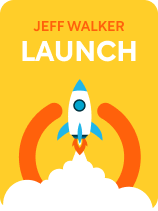

This article is an excerpt from the Shortform book guide to "Launch" by Jeff Walker. Shortform has the world's best summaries and analyses of books you should be reading.
Like this article? Sign up for a free trial here.
What should you do before you even mention sales? How can you make a product launch an event that people don’t want to miss?
In Launch, entrepreneur and digital marketing expert Jeff Walker says that you should prioritize giving value and building customer engagement rather than focusing on sales to launch a product online quickly and successfully. He provides a practical strategy with clear steps.
Keep reading for an overview of Launch by Jeff Walker, and get on the road to a successful product launch.
Launch by Jeff Walker
By following the product launch strategy in Launch by Jeff Walker, you’ll be able to market and sell a product with little to no start-up costs and build a business that grants you flexibility, autonomy, and immediate profits. Walker’s process hinges on creating a powerful tool: the email list.
Jeff Walker is a leading digital marketing specialist and entrepreneur. Since he first developed his Product Launch Formula in 1996, Walker has been teaching and refining it through the experiences of both his personal and client launches.
We’ll explore what sets Walker’s product launch method apart, examine each stage of his formula, and learn how you can apply his strategy to grow your own business.
First, we’ll discuss what a product launch is, how the Internet has changed the marketing game, and how we can adapt to the new landscape for impressive financial results. Next, we’ll dive into the five stages of a product launch, discussing the tools you’ll need and why they work. Lastly, we’ll explore two alternative ways you can launch a product.
The Product Launch in the Online Business World
Walker insists that cultivating interested buyers before releasing the product is the key to a successful launch. At its simplest, a product launch is the process of introducing and selling a new product to potential customers.
According to Walker, the Internet has unique advantages and challenges. To achieve success through Internet marketing, he insists that you must depart from traditional marketing approaches and embrace a launch strategy focused on customer engagement.
Three Keys to a Successful Launch
To stand out in this digital marketing arena, Walker suggests you take advantage of mental triggers—brain shortcuts that influence people to do certain things—in your product launch. These triggers support three key factors of a successful launch: value, relationships, and desire.
Build Value
When you give value before mentioning sales, people will be more eager to purchase your product down the line. Walker writes that, when you focus on value first, the sales will come naturally. When you provide value free of charge, you’re establishing trust and authoritativeness. Even just by giving quality information—a tip or trick—you’re giving people a taste of what your product or service will be, as well as your expertise. When you’re generous with free content, people will appreciate you and feel more inclined to reciprocate by buying your product.
Build Relationships
Walker writes that, to launch a product successfully, you must forge strong relationships with your buyers and potential customers. When you do this, you’ll be more memorable than just loud and stand out from your competitors. One way to build these relationships is to pace your launch over the course of several days or even weeks.
When you build a community around your product, you form not only robust relationships with your customers but also connections between your buyers themselves, which generates more momentum in your launch.
Build Desire
Walker suggests you treat your product launch like a major event to stir up anticipation and build desire. Turn your product launch into a countdown that generates excitement. Walker reasons that this approach activates people’s natural desire to be a part of something bigger.
Just like an event, however, your launch must have an endpoint. By having a definite window, you create an urgency to buy your product. When things are limited, people feel more hastened to make a decision.
To make your launch an event, approach your product launch in five stages.
Stage 1: Create an Email List
Before you even mention your product, attract followers who are interested in receiving regular emails from you. To start building an email list, Walker suggests you:
- Develop your promise. Figure out the core reason people should subscribe to your list. To do this, consider something free and valuable that you can offer through email.
- Identify your target market. Walker suggests looking for a specific group of people whose needs or wants could be met by your product.
- Create a “squeeze page”—a landing page on your website that gives visitors the choice to either subscribe to the email list or leave.
- Encourage people to subscribe with an enticing offer. Give people an immediate incentive to sign up. This should be something free and specific.
Walker suggests three methods of promoting traffic to your page: organic traffic, social media, and paid advertising:
- Organic Traffic—Drive traffic to your page by getting your website to appear higher up in the search engine’s results.
- Social Media—Use social media as a tool to draw attention and direct people to your email list. Social media platforms make it easier for you to discover and interact with these communities.
- Paid Advertising—Use paid advertising to drive more people to your landing page and email list. For cold traffic, use paid ads to convert them into warm traffic by guiding them to your opt-in page. For warm traffic, focus your paid advertising later on in your launch process to encourage your prospects to purchase your product.
Stage 2: Gauge Interest
Once you’ve accumulated an email list, start bringing your product to the attention of your email subscribers. In this step, gauge whether you’ve got a successful product worth launching by soliciting engagement from your followers.
Send a simple email to your followers telling them about the product you’re planning to launch. Walker suggests directly asking for feedback and questions through a survey with questions. Take note of their receptivity to your offer as well as any objections.
Afterward, write another email thanking people for their input and providing a progress update. Maintaining steady communication with your list ensures you’re more frequently at the front of their minds.
Stage 3: Build Anticipation
After you’ve introduced your followers to your offer, send three pieces of marketing content to your email list to build anticipation for your product and convince them to buy. Walker suggests you space these marketing pieces over the course of five to twelve days. The content format doesn’t matter—it could be an email, podcast, video, or even live-stream broadcasts.
In your three marketing pieces, Walker recommends you give your target market the answers to why, what, and how. These questions correspond with the reason, the product, and the benefit.
- The reason: Why should customers buy your product? Why should they care? Why should they listen to you?
- The product: What is your product? What will customers learn or achieve if they buy it?
- The benefit: How will your product benefit customers? How can customers visualize their own transformation by using it?
After answering these questions, answer any major questions you’ve received from your feedback requests. Then, transition into discussing your offer and the logistics of how your followers can finally attain your product (and its benefits) for themselves.
Stage 4: Open to Sales
In this third stage of the launch process, you can open your product to the market. By this point, Walker notes that most of the work is already done. All that’s left to do before you start taking orders is to create a sales page on your website with a video or letter summarizing your offer while emphasizing how buyers will benefit from it.
Then, send a short email with a link to your sales page announcing that your product is available for purchase. For better results, communicate regularly with your followers. Send an email each day of your launch giving updates, expressing gratitude, and answering questions.
To create urgency, consider having the price increase, a special bonus go away, or the offer end completely. Near the end, Walker advises you to send out emails reminding people of your cart’s closing time as many people are natural procrastinators.
(Shortform note: What happens if people add your product to their cart, but don’t make the purchase? Experts offer tips on how to remind your customers to purchase a product they had previously added to a cart by crafting a cart recovery email. In your email, display your customer’s cart and give a link returning them to their cart so that they don’t have to re-enter their information. Also, include a call to action, such as a “Return to Cart” button.)
Stage 5: Follow Up
Continue nurturing your relationship with buyers (and non-buyers) to grow your business long-term. Walker notes that people often feel underwhelmed after purchasing a product. To address this, continue to communicate and deliver more than what they had expected. Strengthen connections by writing an email expressing your thanks, summarizing your launch results, and asking for feedback.
Walker suggests you follow up with and send bonus content to both people who had purchased your product and those who hadn’t.
Product Launch Variation #1: Launch Without a Product
What if you don’t have a product to launch? Walker says you can create a business from scratch with his product launch strategy. With nothing more than an idea, you can gauge interest, build anticipation, and make sales by asking for continual feedback at every step. With this approach, you develop your product as you’re delivering it. This works especially well when you’re offering information or training to others.
Product Launch Variation #2: Launch With Partners
Take your launch to the next level by doing a partner launch. In this approach, Walker suggests teaming up with one or multiple companies to promote your product to their subscribers. By having access to other email lists, you can quickly grow your own.
In the stage leading up to your launch, have your partners send emails telling their followers about your offer and directing them to your squeeze page. In exchange for the increased exposure, your partner receives a portion of your sales.
Walker offers these steps for finding a partner for your launch:
Step #1: Search online for keywords of what your target market might be looking for. The search results will show some companies offering that service.
Step #2: Browse the results for relevant companies in your field that serve your market’s goal and join their email lists. Walker recommends subscribing to around 50.
Step #3: Read their emails as they come in, and see if they promote other businesses. Then, narrow down to three to five best options. To start reaching out to potential partners, Walker says you’ll need to create value to stand out. You can do this by advertising one of their products, offering positive feedback for one of their products, or engaging with them on social media.
Walker says that you should focus on building a lasting relationship with your partners. Before you involve them in your product launch, Walker suggests you run one with your own list first to make sure your product is successful.

———End of Preview———
Like what you just read? Read the rest of the world's best book summary and analysis of Jeff Walker's "Launch" at Shortform.
Here's what you'll find in our full Launch summary:
- How to stand out in an age when anyone can start a business online
- How you can market and sell a product with little to no start-up costs
- Why you should start an email list before you even launch your product






